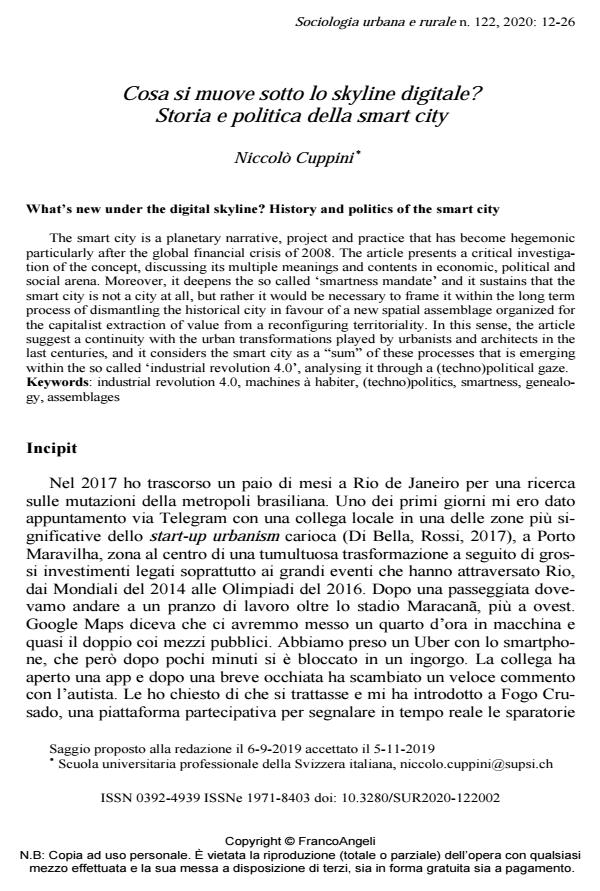What’s new under the digital skyline? History and politics of the smart city
Journal title SOCIOLOGIA URBANA E RURALE
Author/s Niccolò Cuppini
Publishing Year 2020 Issue 2020/122
Language Italian Pages 15 P. 12-26 File size 196 KB
DOI 10.3280/SUR2020-122002
DOI is like a bar code for intellectual property: to have more infomation
click here
Below, you can see the article first page
If you want to buy this article in PDF format, you can do it, following the instructions to buy download credits

FrancoAngeli is member of Publishers International Linking Association, Inc (PILA), a not-for-profit association which run the CrossRef service enabling links to and from online scholarly content.
The smart city is a planetary narrative, project and practice that has become hegemonic par-ticularly after the global financial crisis of 2008. The article presents a critical investigation of the concept, discussing its multiple meanings and contents in economic, political and social arena. Moreover, it deepens the so called ‘smartness mandate’ and it sustains that the smart city is not a city at all, but rather it would be necessary to frame it within the long term process of dismantling the historical city in favour of a new spatial assemblage organized for the capi-talist extraction of value from a reconfiguring territoriality. In this sense, the article suggest a continuity with the urban transformations played by urbanists and architects in the last centu-ries, and it considers the smart city as a "sum" of these processes that is emerging within the so called ‘industrial revolution 4.0’, analysing it through a (techno)political gaze.
Keywords: Industrial revolution 4.0, machines à habiter, (techno)politics, smartness, genealo-gy, assemblages
- Handbook of Research on Developing Smart Cities Based on Digital Twins Caterina Mele, pp.1 (ISBN:9781799870913)
- Climate-neutral and Smart Cities: a critical review through the lens of environmental justice Ilaria Beretta, Caterina Bracchi, in Frontiers in Sociology 1175592/2023
DOI: 10.3389/fsoc.2023.1175592 - Platforms in the city and cities at the service of platforms: An urban perspective on the platform economy and workers’ responses Maël Dif-Pradalier, Thomas Jammet, Julie Tiberghien, Filippo Bignami, Niccolo Cuppini, in The Economic and Labour Relations Review /2023 pp.637
DOI: 10.1017/elr.2023.53 - Capitalism in the Platform Age Niccolò Cuppini, pp.65 (ISBN:978-3-031-49146-7)
- Research Anthology on Measuring and Achieving Sustainable Development Goals Caterina Mele, pp.848 (ISBN:9781668438855)
Niccolò Cuppini, Cosa si muove sotto lo skyline digitale? Storia e politica della smart city in "SOCIOLOGIA URBANA E RURALE" 122/2020, pp 12-26, DOI: 10.3280/SUR2020-122002